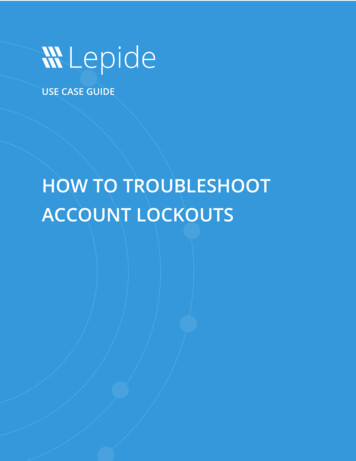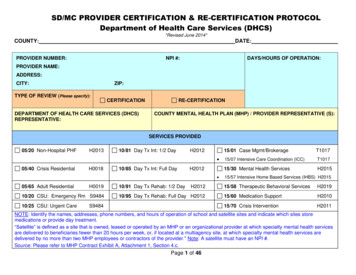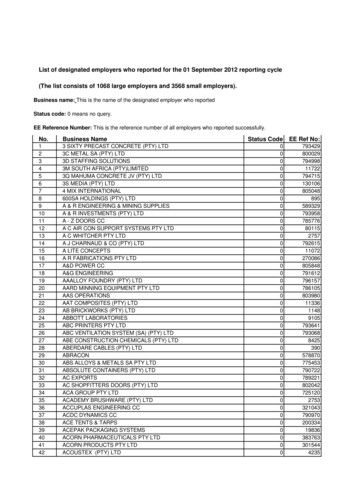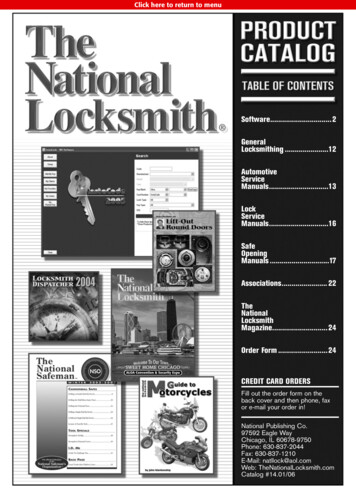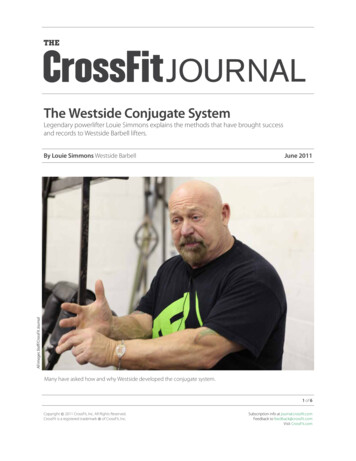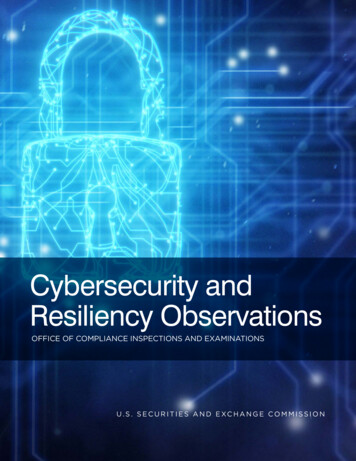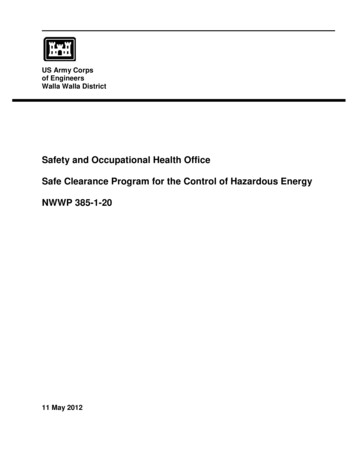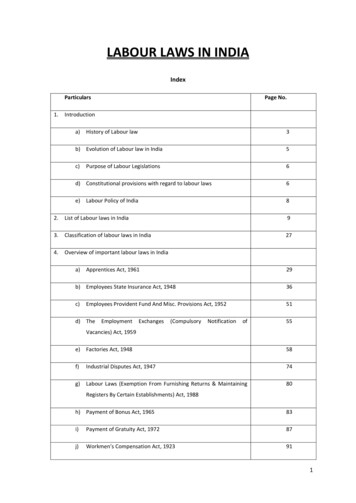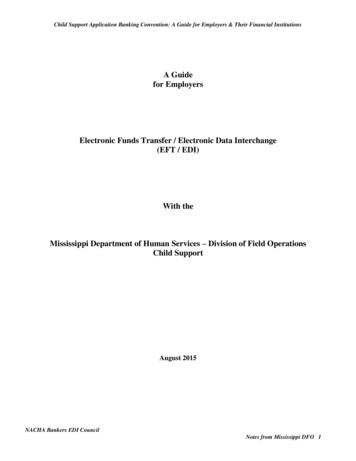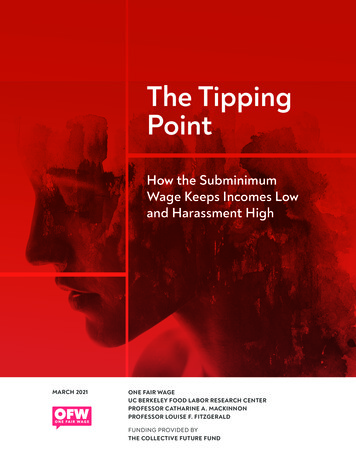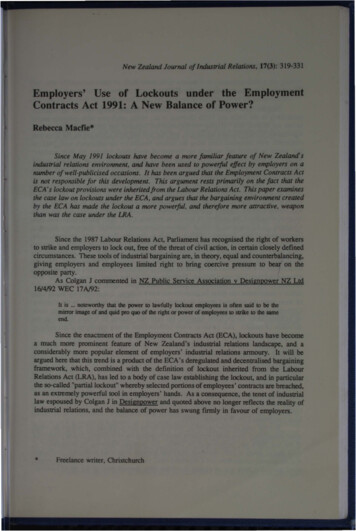
Transcription
New ,Zealand Journal of Industrial Relations, 17(3): 319-331Employers' Use of Lockouts under the EmploymentContracts Act 1991: A New Balan ce of Power?RebeccaMa cfie*Since May 1991 lockouts have become a more familiar featu e of New Zealand'sindustrial re,lations environment, and have been used to powerful effect by employers on anumber of well-publicised occasions. l.t has been argued that the Employment Contracts Actis not responsible for this development. This arg,wnent rests primarily on the fact that theECA 's lockout provisions were inher,ited from the Labour Relations Act. This paper examinesthe case law on lockouts under the ECA, and argues that the bargaining environment createdby the ECA has made the lockout a more powerful, and the efore more attractive, weaponthan was the case under the LRA.Since the 1987 Labour Relations Act, Parliament has recognised the right of workersto strike and employers to lock out, free of the tmeat of civil action, in certain closely definedcircumstances. These tools of industrial bargaining are, in theory, equal and counterbalancing,giving employers and employees limited right to bring coercive pressure to bear on theopposite party.As Colgan J commented in NZ Public Service .Association v Design power NZ Ltd16/4/92 WEC 17N92:It is . . noteworthy that the power to lawfully lockout employees is o ten said 'lO be themirror image of and quid pro quo of dte right or power of employees to str&e to the sameendSince the enactment of the Employment Contracts A ct (ECA), lockouts have becomea much more prominent feature of New Zealand's industrial relations landscape, and aconsiderably more popular element of employers' industrial relations armoury. It will beargued here that this trend is a product of the ECA' s deregulated and decentralised bargainingframework, which, combined with the definition of lockout inherited from the LabourRelations Act (LRA), has led to a body of case law establishing the lockout, and in particularthe so-called "partial lockout" whereby selected portions of employees' contracts are breached,as an extremely powerful tool in employers' hands. As a consequenc,e, the tenet of industriallaw espoused by Colgan J in Designoower and quoted above :no longer reflects the reality ofindustrial relations, and the balance of power has swung funily in favour of employers.*Freelance writer, Christchurch
320Rebecca MacfieThe role of lockouts prior to the ECADespit eNew Zealand's industrial relations climate being marred by conflict,particularly in the 1960s and 1970s (Brosnan et aL, 1990), employers were generally loatheto use the lockout tool. Hughes (1990) noted that lockouts had historically been of Jittlesignificance in New Zealand labour law, and that this had been explained on the basis thatemployers were restrained from using the lockout weapon by the obligation, until 1981, topay wages to locked out workers, or because of employers' concern for their workers'welfare. A more significant reason for the relative dearth of case law on lockouts, arguedHughes, was the restrictive definition of lockout which comprised both the employers' actionand its motive, and the consequent difficulty of proving a lockout had occurred.Such case law as did develop prior to the ECA did, however, hint at the unrealisedpower of the lockout weapon. The notion that a lockout could be something other than aliteral locking of the factory gates was well established under the LRA. In NZ Dairy Foodand Texti.le Workers, Union v Cavalier B emworth Ltd [1991] 2ERNZ (WLC32), the unionsuccessfully alleged the employer's action in imposing a new shift system on workers wasa lockout In NZ Seamens, JUOW & Federated Cooks and Stewards' Union .etc v ShippingCorporation of .New Zealand [1989] 1 NZll.,R 6, the idea that a mass dismissal couldconstitute a lockout was recognised. The Public Service Association, in NZ Pub.lic ServiceAssociation v Armourguard Rescue Services Ltd [1989] 3 NZII R 343, recognised byimplication the conoept of the "partial lockout" by arguing (unsuccessfully) that theintroduction of a new rescue frre appliance befo e the customary consultativ·e discussions onmanning had been held was a lockout. Similarly, in NZ Ai l.ine Pilots, Association v Air NewZealand [1991] 2 ERNZ (AEC35), the plaintiff union argued (again, unsuccessfully) that theairline's requirement that pilots be clean-shaven was a lockout. It is noteworthy that in eachof these cases the employer argued its action was not a lockou including in the ShippingCorporation case where the lockout was held to be lawful. In contras in the leading caseson lockouts under the ECA the employer has expressly ensured its actions fell within thedefinition of lockout. This points to a new consciousness among employers of the potencyof the lockout which was absent prior to the 1991 Act.It is arguable that in the climate of high inflation that prevailed in the 1970s and 1980semployers did not need to resort to lockouts to achieve their aims. For example, in the 1989and 1990 wage rounds under the LRA, wage settlements were markedly below the rate ofinflation . The 1989 wage round followed a 4.5% path, while inflation for the December 1989quaner ·was 7.2%, and in 1990 the Council of Trade Unions-Labour Government "growthagreement. kept most workers in the collective bargaining system to a 2% pay rise, whileinflation for the .D ecember quarter that year ran at 4.8%. Analysis by Harbridge of the fivewage rounds between 1984 and 1988/89 showed neither awalid nor non-award settlements hadkept pace with inflation as measured by the CPI, largely because the ·effects of GST had notbeen compensated for (Harbridge, 1990).But the wage attrition caused by inflation during this period did not address the manyother issues which arose as key employer concerns during the very difficult trading conditionsof the late 1980s and beginning of the 1990s. For example, following the deregulation ofshop trading hours in 1989 there was enottnous pressure from retail employers, confrontedwith height ened competition and a depressed retail trading environment, for cuts to w·e ekendpenal rates. Y·e t there was no att empt to enforoe these demands through the use of lockouts.
-Employers' Use of Lockouts321The same observation could be made about other sectors of the economy during this period- among others, the hotel, transport, stores, education sectors - where employers sought majorconcessions on such issues as penal mtes, hours of work and the use of casual workers.The historical rarity of lockouts was noted by Geare (1988), who suggested:"Lockouts are so few in number because there is rarely any need for employers to use alockout - even if they warn a stoppage of work. If they really 'Want a stoppage, then inpractically all cases 'they can trigger a strike eilher by their ,actions or by their refusal toact."A ,more important reason. and one which will be explored later in this paper, li es inthe influence of the highly regulated and centralised system of award bargaining, which ,captured 79% of all unionised private sector workers and 52% of unionised public sectoremployees in 1989/90 (Harbridge, 1991). The practicaliti es of this system meant that forlockouts to be effective employers would have had to act in a highly organised anddisciplined manner, but the system itself militated against this degree of cohesion. As hasoften been commented, the process of award bargaining was relatively remote from mostemployers, who by and large accepted the outcome as a fait accompli. Indeed, for manyemployers the system had benefits: Harbridge (1991, supra) not ed that the award systemprovided low wage outcomes and low transaction costs for employers, and McAndrew andHursthouse ( 1990) found "little overt dissatisfaction with patterns of interaction betweenemployers and unions., and relativ ely little dissatisfaction with the outcomes of the existingsystem." 'Therefore, it is arguable that lockouts were rare in the pre-ECA ,environmentbecause employers lacked the necessary motivation.The l991 Act: the new order'To test the proposition that the ECA has made the lockout a more accessible andeffective weapon than it was under the LRA, it is necessary first to canvass the relevantprovisions of both statutes.The statutory definition of lockout in s62 of the ECA is identical to the LRA 'sdefinition at s232. A lockout is the act of an employer in closing, suspending, ordiscontinuing all or part of its business, or wholly or partially discontinuing the employmentof any workers, or in breaking some or all of its contracts of service, or in refusing to engageworkers nonnally engaged by the employer, with a vi ew 'to compelling any workers, or to aidany other employer to compel workers, 'to accept terms of employment or to comply with anydemands made by the employer.The circumstances in which S'trikes and lockouts are unlawful and lawful e laid outin ECA s63 and s64 respectively. Section 63 makes unlawful any strike or lockout whichoccurs while a collective employment contract (CEC) relating to the employees involv ed isin force; or if it relates to a dispute or a personal grievance; or to any matter dealt with underPart I (freedom of association) of the ECA; or if the action concerns whether more than oneemployer will be bound by a CEC; or if the requifed notice provisions in essential serviceshave not been complied with. Strikes and lockouts are lawful under the E CA if they are notunlawful under s63, and if they relate to the negotiation of a CE C for the employeesconcerned.The count erparts to these sections under the LRA were s223 and s234. The principal
322Rebecca Macfi·edifferences between the two statutes are that the LRA allowed strikes and lockouts overdisputes of intefest when the relevant award or agreement had no more than 60 days until itexpired, or if they related to a "new matter" (a concept absent from the ECA), or to thenegotiation of a redundancy agreement. The LRA rendered unlawful strikes and lockoutsover disputes, personal grievances, demarcation disputes, union membership or change ofunion coverage, cancellation of union registration, or where the action occurred more than 60days before the expiry of the relevant award or agreement, or in essential industries wherethe notice requirements had not been met. The ECA mirrors the LRA's provision that strikesand lockouts on health and safety grounds are not unlawful.Hence, the ECA 's lockout provisions owe much to the LRA. In practice, however,profound differences have emerged in te1n1s of employers' willingness and ability to uselockouts to effect change. The reason for this lies in the interplay between the ECA 's lockoutprovisions and its bargaining framework.The ECA has shifted industrial relations from a ·Corporatist model to a contractualistmodel (Chmchman, 1991). It provides for individual and collective ·contracts which bind onlythe individual employers and employees who are dir ect parties to the contracts. Collectivecontracts remain in force as collective instruments only until their expiry dates. Unless a newCEC is negotiated, e.mployees are automatically deemed to be on individual employmentcontracts (IECs) which incorporate the tetrns of the expired CE·C. Union membership isvoluntary and unions have no special status in the industrial process. Workers may select anybargaining agent - not necessarily a union - to epresent them, or they may representthemselves. The employer must recognise its workers' authorised bargaining agents, but theECA does not compel it to negotiate with those agents. The bargaining proc·ess itself isnon-prescriptive, and can take any course the parties choose. The E·C A is neutral as towhether settlements are achieved, and leaves the negotiation of employment contracts entirelyin the hands of the panies.In contrast, the LRA provided for awanls to bind all workers and employers in theindustry or occupation to which the document applied, and for agreements to bind all workerswhose employers were signatories. Unions, rather than individual workers, were parties toawards and agreements, and unions had recognised bargaining rights on behalf of workers.The LRA provided for awards and agreements to remain in force as collective documents forup to three years beyond their expiry dates. Compulsory union membership under awards andagreements could be achieved either by ballot of workers or agreement with the employernegotiators, and unions had exclusive coverage rights over workers captured by theirmembership rules. The negotiation of awai!ds was highly regulated through the process ofcompulsory conciliation, whereby employer and union advocates fotrned conciliation councilschaired by mediators employed by the Government Mediation Service. If negotiations brokedown, the dispute would be referred to the Arbitration Commission, which would endeavourto get the parties back to the bargaining table or, if requested by both parries, could arbitratea settlement.The LRA also provided for agreements, which were achieved by voluntary negotiationand bound only the employers and unions who actually negotiated them. However, until the1990 Labour Relations Amendment Act, unions had exclusive power to cite employ ers outof award coverage for negotiations for a separate agreement The amendment gave employerswith more than 50 workers power to initiate the citing out process. In common with theECA, the L.RA, up until the 1990 amendment, contained no provision for compulsoryarbitration, although the 1990 amendment introduced compulsory final offer arbitration incircumstances where protracted negotiations had failed to achieve a settlement
Employers' Use of Lockouts323The outcome of this radical change in the bargaining process has been a rapid shiftfrom large, multi-employer awards to a predominance of enterprise-based contracts (Harbridgeand Moulder, 1992). It is in the context of the ECA's decentralised, face to face mode ofbargaining that the effective power of the lockout has been magnified.Lock outsunder the Employment Contracts ActThe ftrSt case of imponance in testing this proposition is Prendergast v AssociatedStevedores [1991] 2ERNZ (AEC20). This followed an earlier decision of the Labour Court(sitting as the Employment Tribunal) between the same parties, which held that the provisionsof the employees' expired award restricting the use of casual labour by the employer fotrnedpart of their IECs under sl9(4) of the ECA. Following that decision, the employer notifiedthe employees that it intended bfeaching, under s62(l)(c), the provisions of their IECs relatingto the use of casual labour, until they agreed to a new CEC which eliminated the veryprovisions it intended breaching, and to which the Waterfront Workers' Union was not apany. Rejecting the employees' pleas for compliance orders, interim and pe1n1anentinjunctions, Travis J held that the employer had been using a "legitimate tool of industrialrelations, namely the threat of a lockout", to strengthen its bargaining position.This case, then, established that employers who failed to achieve what they wantedthrough negotiations for a CEC could lawfully impose the specific changes they sought underthe protection of s62(l)(c). This fotin of action, conveniently dubbed the "partial lockout"'because it amounts to something less than a lit eral locking out of the employees from theirplace of work, was further developed in Paul and Ors v NZ Society for the Intellectually,Handicapped Inc 15/1/92 WEC 1/92 W 127/91. The IHC, faced with a financial crisis, wasseeking two CECs covering different sections of its workforce, and wanted changes to itsemployees' tetms and conditions to achieve significant cost savings for the organisation.When negotiations with the employees' bargaining agent failed to yield agreement, IHCnotified the employees it intended breaching those provisions of their IECs that it wantedeliminated from the proposed CEC. They were told the action would sav e the IHC 4.2million within six months, and that it was being taken 'w ith a view to compelling them oaccept new tetnls of employment.Unlike the Prendergast case, the IHC action threa ened to have an immediate impacton employees' wage packets. They claimed the action was a breach of their IE Cs and soughtfrom the Employment Court a compliance oroer and injunction restraining IHC fromcommitting the br:eaches. Castle J found rn C's action was a lockout under s62(1)(c) in that"fundamental tettns" of the employees' contracts had 'been breached. The lockout related tothe negotiation of a CEC and was therefo11e lawful under s64 (l)(b). In using the"fundamental terms" test of whether the employees' contracts had been breached, Castle Jdrew on the Armourguard case (supra), heard under the LRA. In that case, which concernedwhether the employer's action in introducing a new re scue frre appliance prior to customaryconsultative discussions with the union was a lockout, and if so whether it ·was unlawful,Goddard CJ said:If the [new flre appliance] is introduced, and 'the respondent requires the workers to operateil, would lhat requirement be so fundamental a breach of the contract of employment atpresent in existence between the parties as to entitle the workers o say "you cannot orderus to do this, we are entitled to cancel the contract of employment and to treat yourdirection as a dismissal"?
324Rebecca Macfi,eIn Armourguard, the answer to the question was "no". It was neither an ,e xpress nor impliedtetrn of the employees' contracts that consultation take place. In IHC, however, theemployer's action in breaching its employees' contracts, with the effect of immediatelyreducing their earnings, was held to be such a fundamental breach that it constituted a lockoutunder s62(l)(c). The implication of the fundamental te1111 test, and its application in IHC,seems to be that 'the more an employer's action goes to the very heart of theemployee/employer relationship - that is, to their wages and conditions and other mattersembodied in the employment contract - the more likely the action will be held to be alockout and therefore, provided the action is lawful, immune from compliance orders or tnJuncuons.The IHC decision also underlines the absenee of any requirement under the E CA (asunder the LRA) to bargain in good faith. Drawing on NZ Public Service Association' vAnnourguard Rescue Services Ltd [1989] 2 NZILR 405, Castle J held the only relevant issuefor the Coun was whether negotiations were being held, not their quality or the bargainingstrength of the parties. (See also Hyndman and Unkovich v Air New Zealand Ltd 16/10/91AEC 19/91 A250 and A251.91 at page 3).Taken together, P endergast and IHC rev,e al the manner in which employers canlawfully thrust change on employees when negotiations have failed to produce the desiredsettlement. Thus the decisions create an irreconcilable conflict with the ECA's fundamentalpremise of sanctity of contract, and with earlier decisions upholding that principle (forinstance, Resident Doctors' Assn v Otago Area Health Board [1991] 2ERNZ (CL C 41), andGrant v Superstrike Bowling Cent es Ltd ALC 81/91). The ability to use s62(1)(c) to targetunwanted provisions in contracts has directly undernlined s19(4) of the ECA, which providesthat when a CEC expires employees are deemed to be on IECs based on the tetn1s of theexpired CEC. In the light of IHC and Prendergast, s19(4) need not impede a determinedemployer from imposing its will on employees. It is ironic to note that some casesconcerning breaches of sl9(4) (for example, United Food and C.hemical Workers' Union vTalleys Fisheries Ltd unreponed, 9 August 1991 WLC 73/91) may have produced differentr esults had the employer sought the protection of s62(1)(c).Further, the ability of employers to follow the example of IHC and, in effect, imposenew tenus on employees, undetmines the very object of Part IV of the ECA, whichestablishes that employment contracts create enforc·e able rights and obligations and that theprimary remedy for any breach of contract is a compliance order. Provided an employer canestablish it has acted lawfully under s62(l)(c), workers can expect no relief from the Court.Significantly, Castle J in /H C rejected the view of his ,c olleague Colgan J in Air NewZealand (supra). Colgan J found that the definition of lockout at s232(l)(c) of the LRAcontemplated compliance with a demand that was independent of the events which constitutedthe breach of the contract of employment. In Air New Zealand it was held the demand andthe breach were one and the same thing - that pilots be clean-shaven.This interpretation has been aptly described as "involving a gloss to the plain wordsof the s62 definition of lockout" (Toogood, 1992). Section 62(1 )(c) contemplates the act ofthe employer in ". breaking some ·or all of the employer's employment contracts . with aview to compelling any employees . to accept tetnts of employment or comply with anydemands made by the employer". There seems no suggestion from a plain r,e ading of s62 thatthe action of the employers in IHC and Prendergast in breaking the employment contractsin a manner that corr esponded precisely with the demands they were making of the employeesdid not fall within the ambit of the section. Obviously, however, had Colgan J's analysis in
Employers' Use of Lockouts325Air New Zealand been correct, the climate for employers wanting to unilaterally imposechanges on workers would have been considerably more hostile than it now is as a result ofIHC and Prendergast.In IHC Castle J pointed to the need only to illustrate that negotiations for a CEC werebeing conducted be oiie a lockout could be lawful under s64(1)(b), and held that thebargaining s ength of the parties and quality of the negotiations were i:nelevant to the Coun.In fact, in the subsequent D,esignpower case (supra)., e en this meagre requirement appearsto have been abandoned by the Court. In this case Designpower employees, aware thecompany wanted to feduce their redundancy entitlement prior to laying off part of itsworkforce, refused to negotiate for a CEC and told the company they wanted IECs. 'T hecompany threatened to lock them out with a view to compelling them to negotiate a CEC.The employees' agent, the PSA, alleged the lockout was unlawful because it did not relate ,to the negotiation of a CEC, and because it offended against s63( l)(d), which prohibits strikesand lockouts relating to the ECA' s freedom of association provisions. Colgan J held that thelockout was law ul even though negotiations for a CEC were not underway. The actionrelated to the negotiation of a CEC, in the sense that the company wanted to compel itsemployees to negotiate with it for such a contract. It was held that Parliament had notintended s64( 1)(b) to be Iiestricted to circumstances where negotiations had actuallycommenced.The PSA's allegation that the lockout threat ofiended against s5 of the E CA (whichestablishes the right of employees to choose whether to associate f:or the purposes ofadvancing their collective employment interests, and that no undue influence can be broughtto bear on any person by reason of that person'' s association or lack of association with otheremployees) also failed. Colgan J held that s5., as an objects section, did not confersubstantive rights.It has been suggested that this decision will put employees in a strong position whendealing with employers who refuse to negotiate for a CEC. That may be so. But the impactof the decision is nevertheless to tip the balance of bargaining power clearly in favour ofemployers. Designpower sanctions the use of lockouts to coerce employees to associate withone another to negotiate a CEC. Employees, however, are specifically denied thecorresponding power by s63(e) of the ECA, which makes it unlawful for employees to strikewith a view to compelling employers to associate together for the purpose of negotiating aCEC.The idea of the lockout as the "minor image and quid pro quo" of the strike is furtherundetnrined by the Court's ruling in Hawtin v Skellerup Industrial Ltd CEC 28/92 C 8/9216/6/92. In that case the company issued lockout notices to two workers to compel them toagree to a CEC. After one of the workers agreed to sign the contract the company proceededto lock out the sole remaining dissident. Palmer J held that the legislation allowed thelockout of a single worker, even though the definition of lockout at s62 efetted to employeesin the plural. It was held that there was ''no conceptual problem, either in logic or in law"presented by a lockout of one work er who refused to si,gn a CEC which., by definition, mustbind two or more employee parties. It did not logically follow that, because a commonunderstanding, agfeement or concened action by employees 'Was a prerequisite to a strike,a lockout in a corresponding opposite way must extend to two employees. While strikes andlockouts were opposites, they had distinctly different constituents which were not simply thereverse of the differing elements of each.At first glance the E CA may hav,e appeared to con er some protection against coeocivelockout action under s57, which provides remedies against contracts procured by harsh and
326Rebecca Mactieoppressive behaviour, undue influence or duress. However, Adams and O s v AllianceTextiles (NZ) Ltd [1991] 2 ERNZ (CEC 22) effectively dispels this possibility. In this caseit was argued employees were coerced into agreeing to new contracts by the employer'simposition of a lockout, and that this amounted to economic duress. Goddard CJ held thatthe lockout in question was lawful and did not amount to duress. The Chief Judge's analysisof the law on whether, in the industrial relations cont ext, a lawful act can constitute economicdmess leaves little scope for employees to seek the shelter of s57 in the event of a lawfullockout. It was noted that the E CA did not grant immunity for lawful strikes and lockoutsfrom proceedings under s57, as it did from proceedings in tort (s73) and from applicationsfor injunction (s74), and that an allegation of duress arising from a lockout which may belawful could not be dismissed out of hand by the Court and must be treated seriously. Butthe Court would necessarily approach such a suggestion with caution, the main reason beingthat Parliament had liecognised the legitimacy of strikes and lockouts in certain circumstances.To recognise lockouts as amounting to economic duress would carry the same consequencefor strikes. Therefore, "there would need to be a most exceptional set of circumstances tojustify [such a finding]". In holding that the facts of the Alliance case did not warrant sucha finding, Goddard CJ gave a clear indication of the difficulty employees would face inseeking the protection of s57 in lawful lockout situations:It may have been otherwise (I put it no more strongly than that) if there had been aprolonged lockout. finally bringing employees to their knees by virtually starving them intosubmission to the employer's demands .The power of the lockout: is the ECA responsible?It has been argued that the rnc style of lockout could have occurred under the LRAand is not the result of the ECA (Birch, 1992). The crux of this argument is that thedefinition of lockout is the same under the ECA as it was under the LRA. Banks (1992),however, argues that while IHC-style lockouts could in theory have occurred under the LRA,in practice they were most unlikely given the LRA' s provision for awards and agreementsto continue in force for up to three years beyond their expiry dates (s171) and the provisionfor awards and agreements to prevail over contracts of service in cases of conflict (sl74).Banks' proposition calls for further development The fact that an aw d or agreementcould continue in force for up to three years beyond its expiry date did not preclude lawfulstrikes or lockouts ov er disputes of intel'est during that time. Hughes ( 1989) notes that theright to strike or lockout did not cease when the document expired. It was not unknownunder the LRA for a dispute of interest to remain live for a protracted period after thedocument's expiry date, and therefore for the opportunity to take lawful strike or lockoutaction to remain open.The reason IHC-style tactics were unknown under the LRA lies in the nature ofbargaining under that regime, and in particular the nature of award bargainiflg. Technicallyan employer under the LRA could, in the context of a dispute of interest where the documentin question had less than 60 days to run, have imposed a partial lockout under s232(1)(c).However the reality of awtlfd bargaining, whereby nominated employer and unionfepr esentatives were authorised to reach settlements which in many cases bound thousandsof employers across entire industries, was that industrial action by an individual employer
Employers' U.se of Lockouts327would have been ineffective.Take a practical example. ABC Welding is covered by the metal trades award. Thataward is due to expire in 60 days and the Engineers' Union has created a dispute of interestto initiate negotiations for its renewal. For its pan, ABC wants to lower its base pay rate by1% and imposes such a cut under the auspices of s232(1)(c). ABC's employer representativesthen settle the award with the union on the basis of a 2% increase in the base pay rate. Byvinue of the award's subsequent parties pfovision, ABC is bound by the new document, andbecause the dispute is settled the lockout is no longer lawful. The end result is that ABC hasachieved nothing more than a temporary lowering of its wage bill, has brought no influenceto bear on the award negotiations, and has probably seriously marred its relationship with itsemployees.The only circumstance in which ABC's action may have be
introduction of a new rescue frre appliance befo e the customary consultativ·e discussions on manning had been held was a lockout. Similarly, in NZ Ai l.ine Pilots, Association v Air New Zealand [1991] 2 ERNZ (AEC35), the plaintiff union argued (again, unsuccessfully) that the airline's requirement that pilots be clean-shaven was a lockout.
